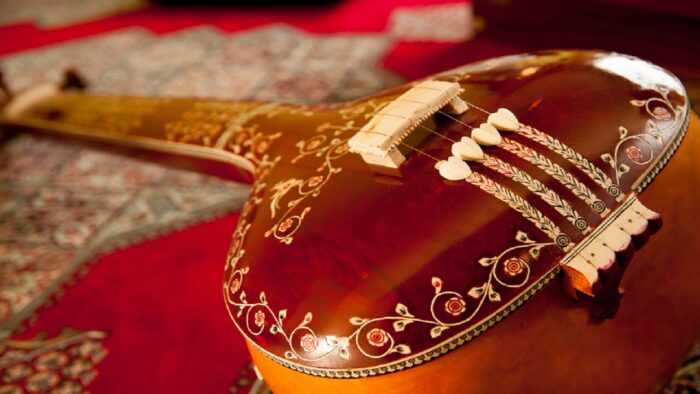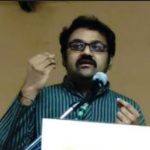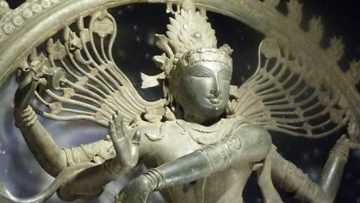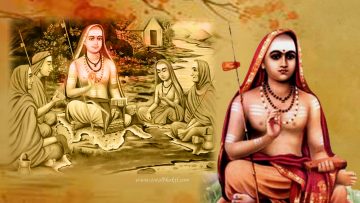Analysis & Demonstration of the kritis of Tyāgarājasvāmi and Muttusvāmi Dikṣita
Introduction
Music is commonly referred to as saṃgītam in our tradition. However, the treatises on saṃgīta śāstra clarify that saṃgītam is a combination of vocal music, instrumental music and dance (गीतं वाद्यं तथानृत्यंत्रयंसंगीतमुच्यते SR 1.21). All these three originate from a subtler entity called ‘Nāda’ (नादाधीनमतस्त्रयम् SR 2.1) which is also the source of the whole Universe (नादाधीनमतोजगत् SR 2.2). Nāda is nothing but the verbal form of Brahman and hence Brahman is referred to as Nāda-tanu (body of Nāda). The primeval Nāda is also referred to as Praṇava. Nāda -bindu-Upaniṣad refers to this when saying that when Praṇava and Brahman unite, Nāda is produced (ब्रह्मप्रणवसंधानंनादः NBU 30). Meditation on Praṇava (or Omkara) is well documented in both the Upaniṣads as well as the Yoga-śāstra. Chāndogya- Upaniṣad begins with ‘ओमित्येतद्अक्षरंउद्गीथंउपासीत’ (CU 1.1) i.e. meditate on syllable Om as the supreme Udgītha. It may also be noted here that ‘upāsana’ especially in the Upaniṣads is used in the sense of dhyana. The Yoga sutras of Patanjali state that Praṇava is the verbal symbol of Brahman (तस्यवाचकःप्रणवः YS 1.27) and this Praṇava is to be meditated on (तज्जपस्तदर्थभावनम् YS 1.28). From all this, it is clear that Nāda as an object of meditation has been there since the Vedic times and as seen from the treatises on music, music has Nāda as its soul (गीतंनादात्मकं SR 2.1) and hence is also capable of being meditated upon. This meditation on Nāda is hence called Nada-upāsana or Nadopāsana. In his kriti Nadopasana in raga Begada, Tyāgarājasvāmi says that the trinities – Śaṃkara, Nārāyaṇa and Brahma are effulgent and able to do their duties because they meditate on Nāda (Nādopāsanace ŚaṃkaraNārāyaṇa vidhulu velasiri O manasā) (Demonstration)
However, it may not be feasible for all to meditate on Nāda itself as it’s a subtle form of Saguṇa Brahman. Dhyāna (which Patanjali defines as the unbroken flow of knowledge of the object being meditated upon तत्रप्रत्ययैकतानताध्यानम् YS 3.2) for the common man needs a grosser object to meditate upon. A marriage of these two aspects i.e. the subtler Nāda and the grosser forms like deities/ Puranic stories etc. was brought about by great vag-geya-kāras of Carnatic music such as Tyāgarājasvāmi and Muttusvāmi dikṣita. We present below a few examples of how they achieved this.
Examples of kritis of Tyāgarājasvāmi (Demonstration)
- Kṛti ‘Bāla-kanaka-maya’ wherein Tyāgarājasvāmi describes the vision of the young Rāma who is shining decked with all ornaments and grand clothing (form for meditation). He chooses raga Athāṇa which is dynamic and grand to describe this dynamic young Rāma who saved him from the thieves. At the same time, when Rāma vanishes from his vision as per the story, he brings in pathos (Elā nī daya rādu) using the same raga.
- In the kṛti ‘Kanu-kontini’, Tyāgarājasvāmi describes the joy of seeing Rama. History tells us that this was when Tyāgarājasvāmi discovered the lost idol of Paṭṭābhi-rāmā that his brother had thrown into the Kaveri river. The raga used here is Bilahari which is known for evoking an emotion of joy and excitement. Also, the way the Pallavi of the song is structured – it glides directly from ‘Ga’ to ‘Ri’ in the upper octave to reflect the excitement.
- Even abstract terms become more comprehendible in the way Tyāgarājasvāmi sets them to music. Take for example the kṛti ‘Sīta-vara’ in raga Deva-gandhari. In the caraṇam, the word ‘Ᾱkaśa’ is set in such a way as to make us experience its expanse.
- Tyāgarājasvāmi was also a master of saṃgatis or melodic variations to bring out the essence of the lyrics. While many scholars opine that these were later additions by his students, there is no denying that Tyāgarājasvāmi did compose many of these. Take for example the kṛti ‘O Raṃgaśāyī’ which glorifies Lord Ranganatha which is the form of Vishnu sleeping in the Kśīra-sāgara. The Pallavi is set in such melodic variations as to symbolize the waves of the Kśīra-sāgara wherein each succeeding variation builds on the earlier one in a wavy pattern.
- Another example is of kṛti ‘Alakalalla’ wherein he describes the curls of hair of Rama through the eyes of sage Viśvāmitra. The melodic variations bring us the feeling of seeing the curly wavy hair tresses!
- In the kṛti ‘Ematicevo’ in Sahana, he pleads to Rama to listen to him and is sad that he is not listening to. This is evoked beautifully through the raga Sahana.
- In another kṛti ‘Mrdu Bhāṣaṇa’, he mentions of the ‘sweet conversational’ nature of Rama. The song is so set to evoke a sweet and soft start when speaking of Mrdu Bhāṣaṇa. For this he uses a unique raga called Maruva Dhanyasi considered to be invented by him.
Examples of kritis of Muttusvāmi dikṣita(Demonstration)
- Kṛti ‘Māmava Paṭṭābhirāma’ in the raga Maṇiraṃgu wherein Dikṣita visually describes the coronation scene of Rāma – the kind of throne he’s sitting, the ornaments he’s wearing, his complexion, his demeanor, people sitting/ standing beside him etc. In addition, Dikṣita uses a raga like Maṇiraṃgu, that is soft yet majestic and used for auspicious occasions, to compose this which elevates the song and helps us meditate on the form of ‘Paṭṭābhirāma’!
- Kṛti ‘Māmava Mīnākṣi’ in raga Varali wherein Dikṣita is describing the majesty of the Goddess who ruled over Madurai. Her triumphant conquest is described in the Caraṇa (Dig-vijaya-pradāyini). The music for this phrase is set such that the grandeur & majesty of Varali is brought to the fore.
- In the Kṛti ‘Śri Subrahmaṇyāya Namaste’, Dikṣita brings out the difference between the Brahmins who worship Muruga on this earth and the celestials who worship him in the heavens by setting them to music in lower and higher octaves respectively(Bhūsuradi-samasta-jana-pūjitabja-caraṇāya & vāsavādi-sakala-deva-vanditāya-vareṇyāya)
- The Navagraha kṛtis of Dikṣita are a treasure where he has highlighted the relative importance of the grahas with musical phrases. A case in point are the kritis of Bṛhaspati and Śukra both of who are the teachers of the Devas and Asuras respectively and hence the songs on them begin in the higher octaves (Bṛhaspate Tārāpate & Śri Śukra Bhagavantam) while all other songs are in the middle and lower octaves.
Concluding thoughts
In essence, we see that through their kṛtis, Tyāgarājasvāmi and Muttusvāmi dikṣita could bring people closer to Nadopāsana. The unique combination of saṃgīta along with relevant sāhitya helps the individual to meditate firstly on the gross form of Saguṇa Brahman manifested by the words, subtle form of Saguṇa Brahman manifested by the words and then the subtler form of Saguṇa Brahman manifested by the Nāda.
Abbreviations used
CU: Chāndogya Upaniṣad
NBU: Nāda-Bindu-Upaniṣad
SR: Saṃgīta Ratnākara
YS: Yoga-sutra
Feature Image Credits: dreamstime.com
HinduMeditationTraditions&Techniques
Watch video presentation of the above paper here:
Disclaimer: The opinions expressed in this article belong to the author. Indic Today is neither responsible nor liable for the accuracy, completeness, suitability, or validity of any information in the article.











